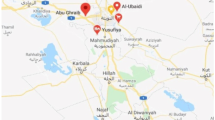Abstract
Estimation of radionuclide concentrations in trees may be required to estimate their radiation exposure. However, concentration ratios of radionuclides from soil to tree species are limited for many radionuclide-tree combinations. To fill this gap, it is investigated in the present paper whether stable element concentration data for leafy vegetables are representative of those for wild tree leaves, and consequently, if these stable element data for leafy vegetables can be used as analogues to describe radionuclides transfer from soil to trees. Data for stable elements in leafy vegetables collected in Japan were compared with those in leaves of about 20 tree species worldwide. The correlation coefficients of element concentrations between leafy vegetables and tree leaves were higher than 0.90 with p < 0.001 by Student’s t test, and geometric means of concentration data for most elements were within the range of data for leafy vegetables. Thus, transfer parameters derived from stable element data for leafy vegetables could generally be used to estimate concentrations in tree leaves if data for the latter are not available. However, some trees accumulate a few elements (e.g., Al, Co, Mn and Si) in their leaves to higher concentrations than observed for leafy vegetables.



Similar content being viewed by others
References
Al-Oudat M, Asfary AF, Mukhalallti H, Al-Hamwi A, Kanakri S (2006) Transfer factors of 137Cs and 90Sr from soil to trees in arid regions. J Environ Radioact 90:78–88
Beresford NA, Barnett CL, Brown J, Cheng J-J, Copplestone D, Filistovic V, Hosseini A, Howard BJ, Jones SR, Kamboj S, Kryshev A, Nedveckaite T, Olyslaegers G, Saxén R, Sazykina T, Vives I, Batlle J, Vives-Lynch S, Yankovich T, Yu C (2008a) Inter-comparison of models to estimate radionuclide activity concentrations in non-human biota. Radiat Environ Biophys 47:491–514
Beresford NA, Barnett CL, Howard BJ, Scott WA, Brown JE, Copplestone D (2008b) Derivation of transfer parameters for use within the ERICA Tool and the default concentration ratios for terrestrial biota. J Environ Radioact 99:1393–1407
Guha MM, Mitchell RL (1966) The trace and major element composition of the leaves of some deciduous trees. Plant Soil 24:90–112
Higley KA (2010) Estimating transfer parameters in the absence of data. Radiat Environ Biophys (this issue). doi:10.1007/s00411-010-0326-9
IAEA (2010) Handbook of parameter values for the prediction of radionuclide transfer in terrestrial and freshwater environments. IAEA-TRS 472, IAEA, Vienna
IAEA (International Atomic Energy Agency) (2009) Quantification of radionuclide transfer in terrestrial and freshwater environments for radiological assessments. IAEA-TECDOC-1616, IAEA, Vienna
ICRP (International Commission on Radiological Protection) (2008) Environmental protection: the concept and use of reference animals and plants, Annals of the ICRP, Publication 108, Pergamon Press, Oxford
Kabata-Pendias A (2001) Trace elements in soil and plants, third edition. CRC Press, Boca Raton
Markert BA (1996) Instrumental element and multi-element analysis of plant samples: methods and applications. John Wiley & Sons Ltd., West Sussex
Reimann C, Caritat P (1998) Chemical elements in the environment. Springer-Verlag, Berlin
Rühm W, Yoshida S, Muramatsu Y, Steiner M, Wirth E (1999) Distribution patterns for stable 133Cs and their implications with respect to the long-term fate of radioactive 134Cs and 137Cs in a semi-natural ecosystem. J Environ Radioact 45:253–270
Sheppard SC, Evenden WG (1990) Characteristics of plant concentration ratios assessed in a 64-site field survey of 23 elements. J Environ Radioactiv 11:15–36
Tagami K, Uchida S (2004) Comparison of transfer and distribution of technetium and rhenium in radish plants from nutrient solution. Appl Radiat Isotopes 61:1203–1210
Tagami K, Uchida S (2009) Radium-226 transfer factor from soils to crops and its simple estimation method using uranium and barium concentrations. Chemosphere 77:105–114
Tagami K, Uchida S, Hirai I, Tsukada H, Takeda H (2006) Determination of chlorine, bromine and iodine in plant samples by inductively coupled plasma-mass spectrometry after leaching with tetramethyl ammonium hydroxide under a mild temperature condition. Anal Chim Acta 570:88–92
Takada J, Takamatsu T, Satake K, Sase H (1994) Data on elemental concentration in land plants by neutron activation analysis. F-58-’93/NIES, National Institute for Environmental Studies, Tsukuba
Takeda A, Kimura K, Yamasaki S (2004) Analysis of 57 elements in Japanese soils, with special reference to soil group and agricultural use. Geoderma 119:291–307
Tsukada H, Nakamura Y (1998) Transfer factors of 31 elements in several agricultural plants collected from 150 farm fields in Aomori, Japan. J Radioanal Nucl Ch 236:123–131
Uchida S, Tagami K (2007) Soil-to-plant transfer factors of fallout 137Cs and native 133Cs in various crops collected in Japan. J Radioanal Nucl Ch 273:205–210
Uchida S, Tagami K, Hirai I (2007a) Soil-to-plant transfer factors of stable elements and naturally occurring radionuclides (1) upland field crops collected in Japan. J Nucl Sci Technol 44:628–640
Uchida S, Tagami K, Hirai I (2007b) Soil-to-plant transfer factors of stable elements and naturally occurring radionuclides (2) Rice collected in Japan. J Nucl Sci Technol 44:779–790
Vandenhove H, Eyckmans T, Van Hees M (2005) Can barium and strontium be used as tracers for radium in soil-plant transfer studies? J Environ Radioact 81:255–267
Willey N (2010) Phylogeny can be used to make useful predictions of soil-to-plant transfer factors for radionuclides. Radiat Environ Biophys (this issue) . doi:10.1007/s00411-010-0320-2
Yoshida S, Muramatsu Y, Dvornik AM, Zhuchenko TA, Linkov I (2004) Equilibrium of radiocesium with stable cesium within the biological cycle of contaminated forest ecosystems. J Environ Radioact 75:301–313
Acknowledgments
This work has been partially supported by the Agency for Natural Resources and Energy, the Ministry of Economy, Trade and Industry (METI), Japan.
Author information
Authors and Affiliations
Corresponding author
Additional information
This paper is based on a presentation made at the second meeting of the Wildlife Transfer Coefficient Handbook Working Group of the IAEA EMRAS II programme (held at the IAEA, Vienna, 22–24 July 2009).
Rights and permissions
About this article
Cite this article
Tagami, K., Uchida, S. Can elemental composition data of crop leaves be used to estimate radionuclide transfer to tree leaves?. Radiat Environ Biophys 49, 583–590 (2010). https://doi.org/10.1007/s00411-010-0316-y
Received:
Accepted:
Published:
Issue Date:
DOI: https://doi.org/10.1007/s00411-010-0316-y




